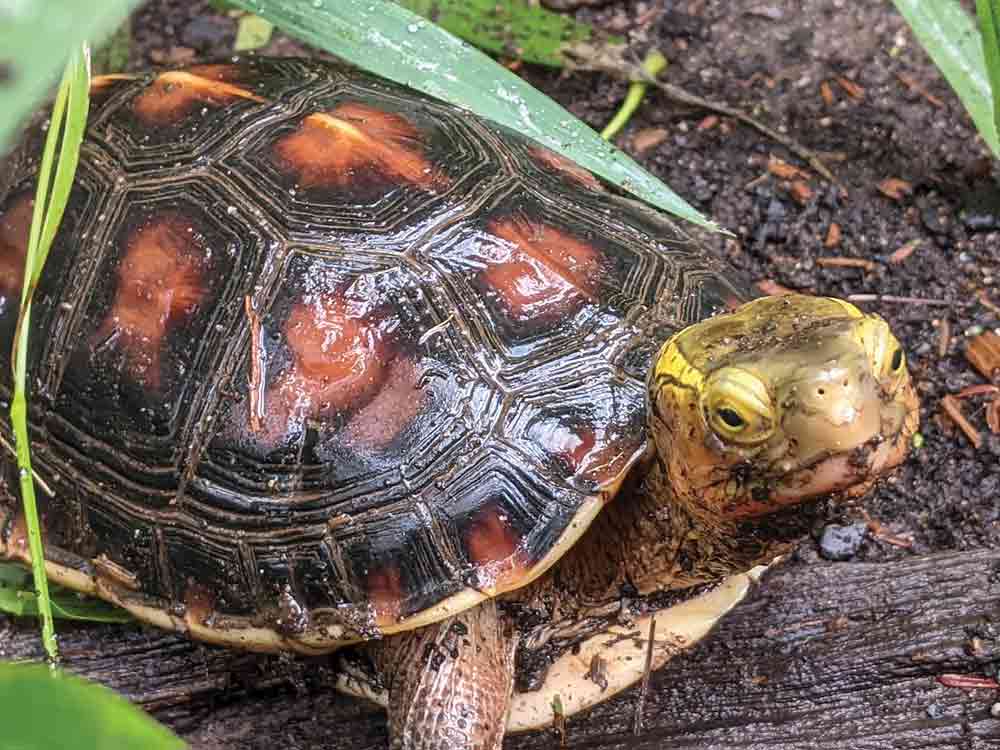Cuora flavomarginata is also known as the snake-eating turtle.
Lots of turtles have an array of common names. This is one of the reasons that biologists and experienced keepers choose to call species by their Latin name. Generally this makes sense, that is unless it is the rare situation where a turtle has an extremely cool common name. For turtle people who purposely choose to work with some of the least imposing animals on the planet, especially when compared to snakes, it is pretty cool to think that the Chinese box turtle, Cuora flavomarginata, is also known as the snake-eating turtle.
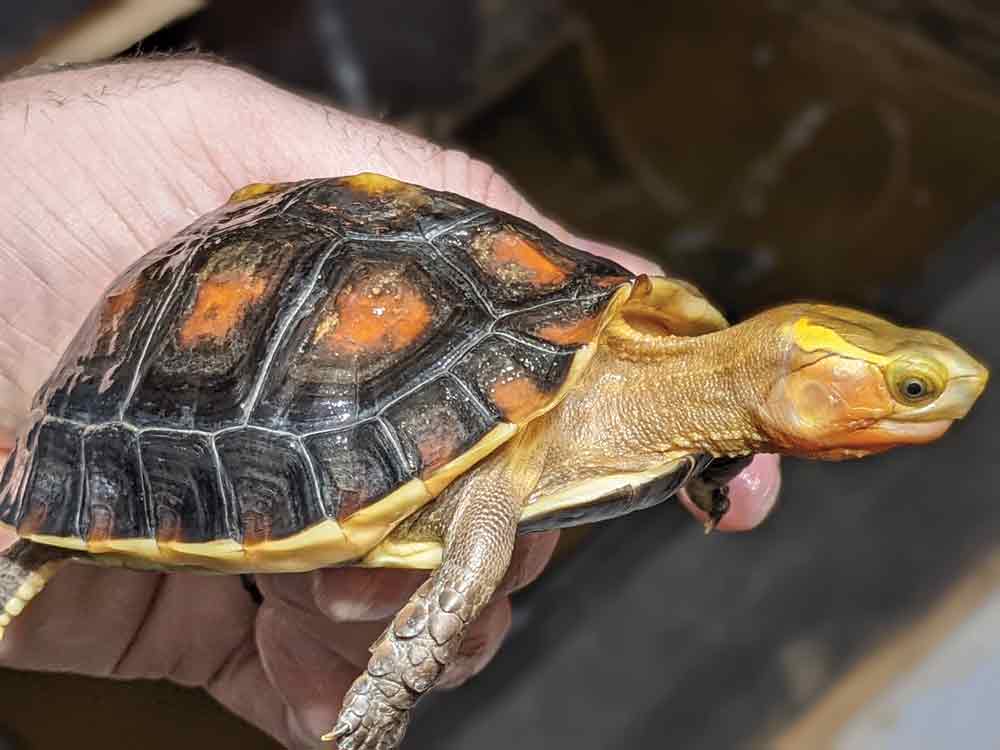
Adult Chinese box turtle. Photo by Anthony Pierlioni.
That being said, Chinese box turtles are known throughout herpetology and herpetoculture circles simply as “flavos,” which is an abbreviated version of their species name. Although “snake eater” sounds much more impressive and is certainly appropriate given their aggressive feeding behavior, the ease of the alternative “flavo” makes it a catchy no-brainer.
What makes this species a no-brainer for keepers is its overall hardiness, good looks, and most importantly, their incredible personalities. To know a flavo is to love a flavo.
Description of Cuora flavomarginata
Flavos have been given a variety of common names including Chinese box turtle, yellow-margined box turtle, golden-headed turtle and the aforementioned snake-eating turtle. Even in terms of the genus in which the species belongs, things have varied over time. Some still consider the species to belong to the genus Cistoclemmys, which is not recognized by all, but does acknowledge that they are not entirely like some of the more aquatic Asian box turtles that also call the Cuora genus home.
The species has been divided into three poorly defined subspecies; the nominate taxon Cuora flavomarginata flavomarginata from Taiwan, C. f. sinensis, a weakly distinguished taxon from southern mainland China that is not currently recognized, and C. f. evelynae from Japan’s Ryukyu Islands.
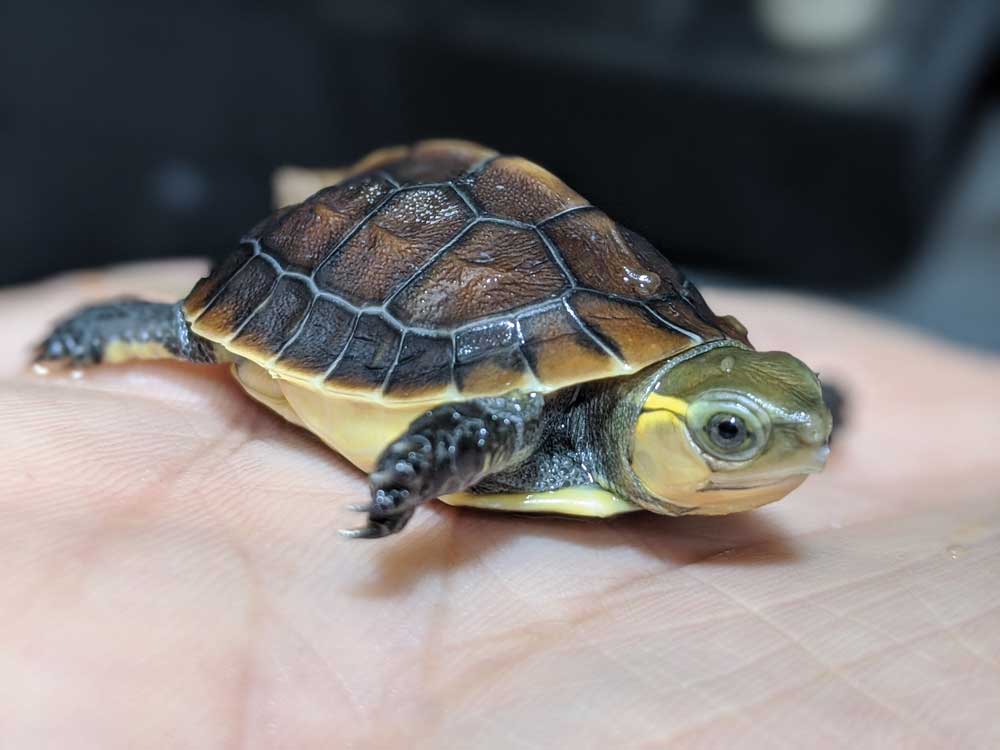
Also known as the golden-headed turtle, Cuora flavomarginata has a bright yellow line on each side of the head. Photo by Anthony Pierlioni.
Flavos are a small, highly domed turtle. In adults, the carapace is a rich, dark brown except for the distinct creamy-yellow stripe down the vertebral keel, and the lightly pigmented lower edges of the marginal scutes and adjacent plastral scutes that form a yellow rim around the edge of the plastron. The plastron is black. Pretty specimens often have lighter, reddish coloration in the middle of each carapace scute. The top of the head has a striking bright yellow line on each side that goes from behind the eye to the back of the head. The skin of the chin and neck is colored a delicate apricot to pink or yellow.
Flavos are not the most sexually dimorphic species one might encounter, but there are several items that make males and females discernible from one another. Mature males have broader and larger tails and heads than do females. In males, tails are longer and thicker and have a more triangular shape than females. We have seen males displaying slightly larger tails as early as one year of age.
Cuora flavomarginata Range and Habitat
Flavos occur in southern China as well as Taiwan and the Ryukyu Islands. One particular habitat was described by Mao (1971) as a forested hill alongside a shaded stream with extremely luxurious high-stemmed vegetation. Under the vegetation of the damp bank, many turtles of this kind were concealed. . . about 100 specimens were collected at that time. Flavos are frequently seen in ponds adjacent to rice fields.
Threats To The Chinese Box Turtle
Reptile enthusiasts outside of the turtle world sometimes do not realize how different things are for turtles, in comparison to herp species often part of herpetoculture. Turtles are arguably the most endangered of all vertebrate groups on the planet. Flavos are no exception. Although the species has been kept and bred in the United States for decades, they are considered Endangered by the IUCN. It is great that the species is and has been produced in captivity. That fact, along with international protection of CITES, means that the species is no longer imported to the US, a win for lawmaking and captive propagation.
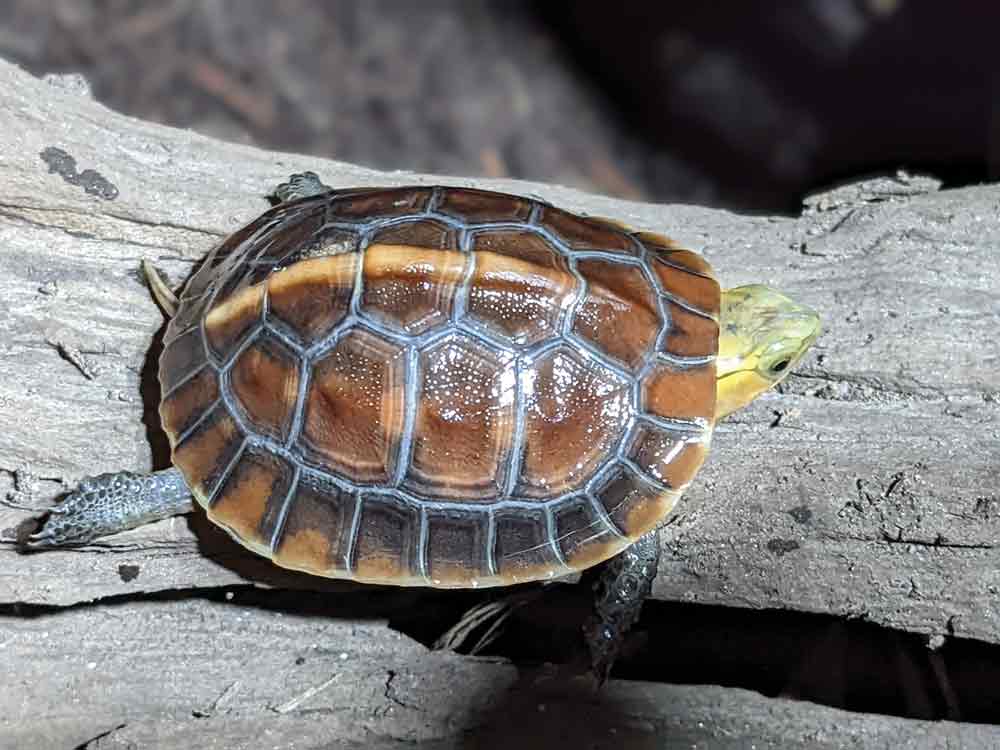
Chinese box turtles are known throughout herpetology and herpetoculture circles simply as “flavos,” which is an abbreviated version of their species name.
Photo by Anthony Pierlioni.
What Do Chinese Box Turtles Eat?
Flavos are arguably the easiest turtle species to feed. Their ravenous appetite, smooth, fast growth when kept appropriately, and the variety of food items they will eagerly accept all combine to make them a dream species. Young animals are happy to live on a diet that includes a staple of commercially available turtle pellets. Mazuri Aquatic Turtle Pellets are the staple for our animals, particularly when young.
Working With The Rare Ryukyu Black-breasted Leaf Turtle
Striped Mud Turtle Care And Breeding
Expert Tips for Happy and Healthy Aquatic Turtles
The juveniles and adults are given a much wider range of food items. A food processor is used to finely chop a large variety of food items, most not commonly offered to or accepted by turtles. As a general rule, smelly items like fruits and high protein sources are most appreciated. Those items flavor the mixture and give the meal its attractive smell—to the turtles anyway.
We prefer to offer fruits that are low on the glycemic index (like berries) and those that have an attractive color to them. We basically avoid citrus fruits. Blackberries, blueberries, raspberries, strawberries, blueberries, banana, tomato, apple, papaya, dragonfruit and watermelon are good choices. For protein sources, we often mix in something like frozen shrimp, chicken, turkey, soldier fly larvae, pinky mice, quail chicks, hard-boiled eggs with shell on, or even high-quality dog food or non-medicated chicken feed. The protein is generally a small part of the mix, which usually includes turtle pellets and often commercial tortoise diet, as well.
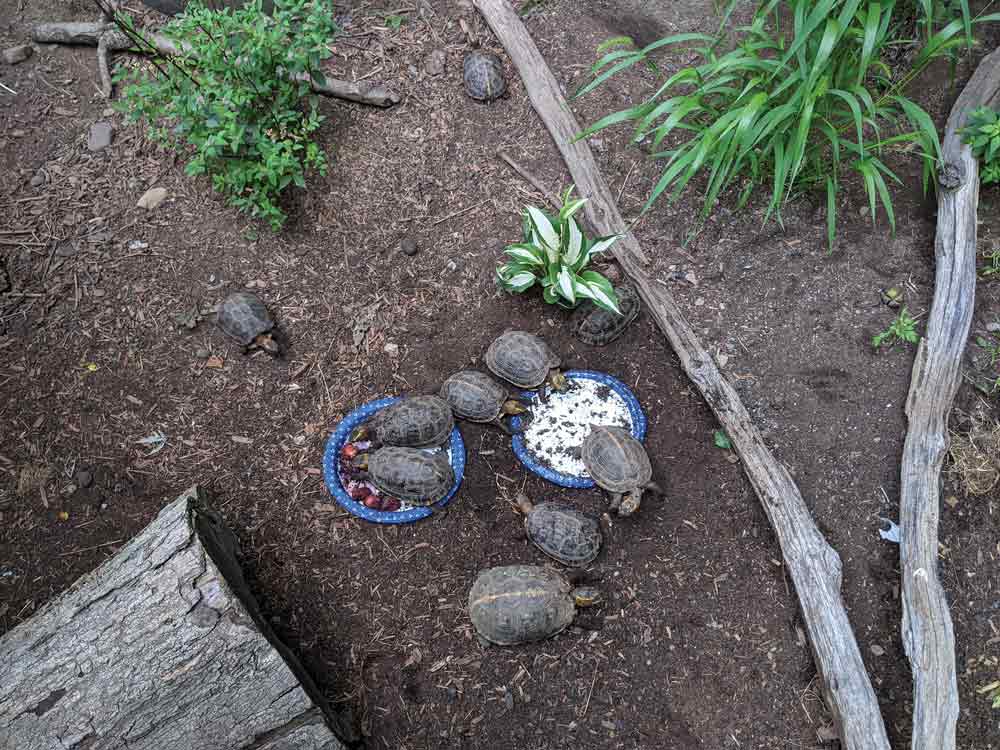
Feed Chinese box turtles a combination of commercial foods for turtles and a variety of berries. Photo by Anthony Pierlioni.
Just as we humans use smoothies to make things like kale more desirable, these mixtures can act as a disguise for less desirable items. While the fruit and protein flavor the meal, we can mix in those less tasty, but vitamin-rich foods, while maintaining the variety that is so important for these omnivores. Things like greens and lettuces, zucchini, squash, sweet potato, peppers, cucumber, etc. are added with no ill effect in terms of the vigor with which they are consumed.
The best part of this species is their personality. They are inquisitive and outgoing. Our young daughters love the flavos, as we can visit their large, heavily planted enclosures together. At first glance, the enclosures seem empty. Within a few seconds, however, you can see the invasive mugwort that we allow to grow in the enclosures start to move, as the turtles begin to ascend upon the humans that have entered the area. After all, humans often mean food is on the way.
Once a plate of food is dropped in a seemingly empty enclosure, less than a minute passes before the plate is covered by every turtle in the vicinity. An enclosure with 15 turtles will see all 15 turtles on the food within seconds, not minutes. Much to the delight of our daughters and any guests that visit, the turtles approach even when there is no food, at which point we need to remind them to keep it moving. This is especially true when open-toed shoes are worn. Toes look yummy to flavos, is all we can tell you.
A friend actually picks up roadkill when he finds it, in an effort to offer variety to his flavos. While we have never seen them kill animals, we have found them with carrion and wondered how it got there. We have no doubt they can and would easily kill snakes and we have seen them eating birds.
Chinese Box Turtle Breeding and Incubation
As with many turtle species, a winter cool down period is necessary for successful production to occur. We have had animals overwinter outside successfully here in Connecticut. We have also kept them in an indoor enclosure and had success breeding them after cooling to a range of roughly 65 to 72 degrees Fahrenheit (18.3 to 22.2 degrees Celsius) during winter. Our goal every year is to collect all adults from their outdoor enclosures once the weather cools in the fall and bring them in for artificial overwintering in the garage. There, the turtles remain between 30 and 50 degrees Fahrenheit (-1.1 to 10.0 degrees Celsius), where they remain completely inactive for about four months.
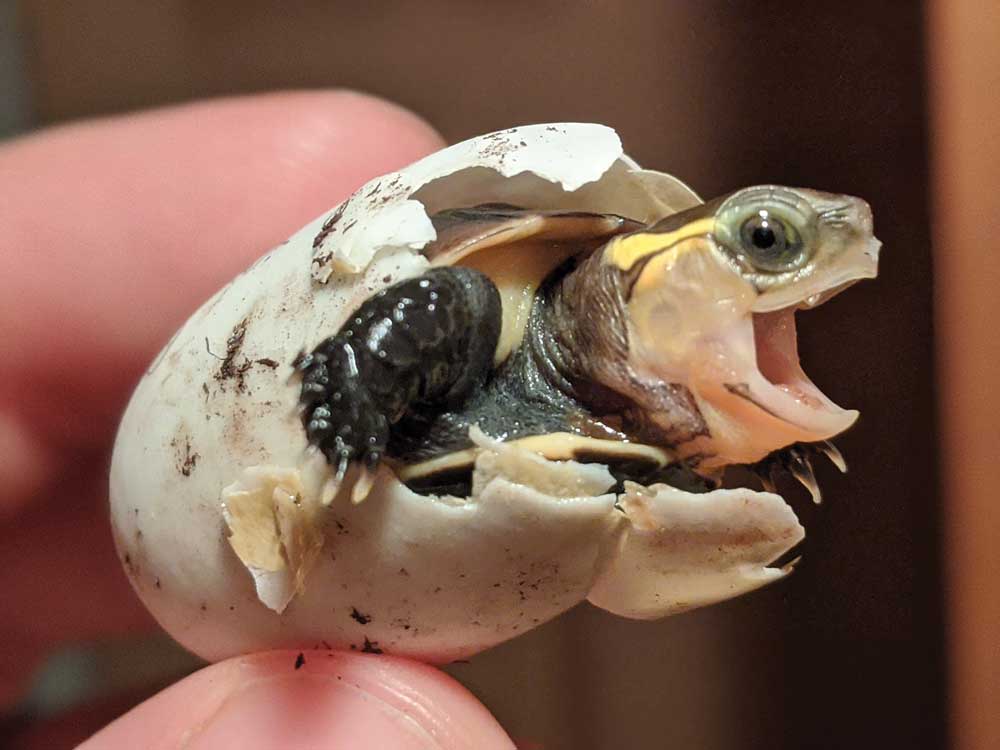
Helping a hatchling out of its egg. Females lay small clutches, usually between one and three eggs. Photo by Anthony Pierlioni.
The biggest challenge with breeding flavos is their voraciousness. They do well when kept in groups, particularly when kept outdoors. However, they are quite adept at finding nesting females and eating her eggs as they are being laid. We have adapted a method of breeding this species first reported by Ray Farrell, the keeper of the Turtle Survival Alliance’s (TSA) Taxon Management Group (TMG) for the species. It is important to palpate females, by placing a finger in the area just in front of the rear legs, to feel for developed eggs being carried. It is much easier and safer to do this for flavos than for North American box turtles, Terrapene sp., that could really hurt a finger. Palpation of eggs is generally easy, unless there is only a single egg clutch.
Gravid females are brought inside to be placed in separate maternity ward enclosures with deep substrate, a hide, and a water dish. A heat lamp is placed to one side, to provide warmer substrate but also a temperature gradient. Females often lay fairly quickly after being brought inside. Occasionally, it will take longer and/or there will be many gravid females at once. In those instances, there is an overflow enclosure, where females wait in shallow water for their chance to get back into the maternity wards. We rotate them through in these cases, returning them outside once oviposition has occurred.
Flavo eggs are large, oblong, and hard-shelled, measuring 38 to 52 mm (1.5 to 2 inches) long by 13 to 25 mm (0.5 to 1.0 inches) wide, and weighing 11 to 18.5 g. Clutch size is usually between one and three eggs, but we have had four egg clutches on several occasions, including multiple by a large female weighing roughly 1300 grams. Fertile eggs develop a chalky, white band around the middle of the egg within a few days and rarely the whole egg will chalk.
Incubation here has been accomplished in a variety of ways. We first hatched the species by incubating on damp sphagnum moss, keeping the eggs on a shelf, at fluctuating temperatures around 78 and 84 degrees Fahrenheit (25.6 and 28.9 degrees Celsius). Since then, we have hatched them on vermiculite with sphagnum atop the eggs, on vermiculite at 1:1 by weight, and in artificial incubators at steady temperatures. We have been both successful and unsuccessful with each of these approaches, including combinations of the varying substrates and incubators used. Flavos do display Temperature Sex Determination, meaning the temperature of the embryo determines the gender.
Common Health Issues of the Chinese Box Turtle
As previously mentioned, it just doesn’t get much easier for a turtle keeper than it does with flavos. That being said, humidity is the one major health concern for the species in captivity. Humidity, and really saturation level, for the turtles is of utmost importance as they grow and develop. In the past, it was thought that diet and rapid growth had much to do with deformities and malformation seen in captive raised flavos. In many of the deformed-shelled, captive animals, we also see things like unnaturally sloped faces and bulging eyes, which likely also come from dry conditions. Unnatural beak formation and underbites are often caused by soft captive diets while being kept only indoors. The great news is, we are seeing less and less of this as proper husbandry has been increasingly shared over the decades.
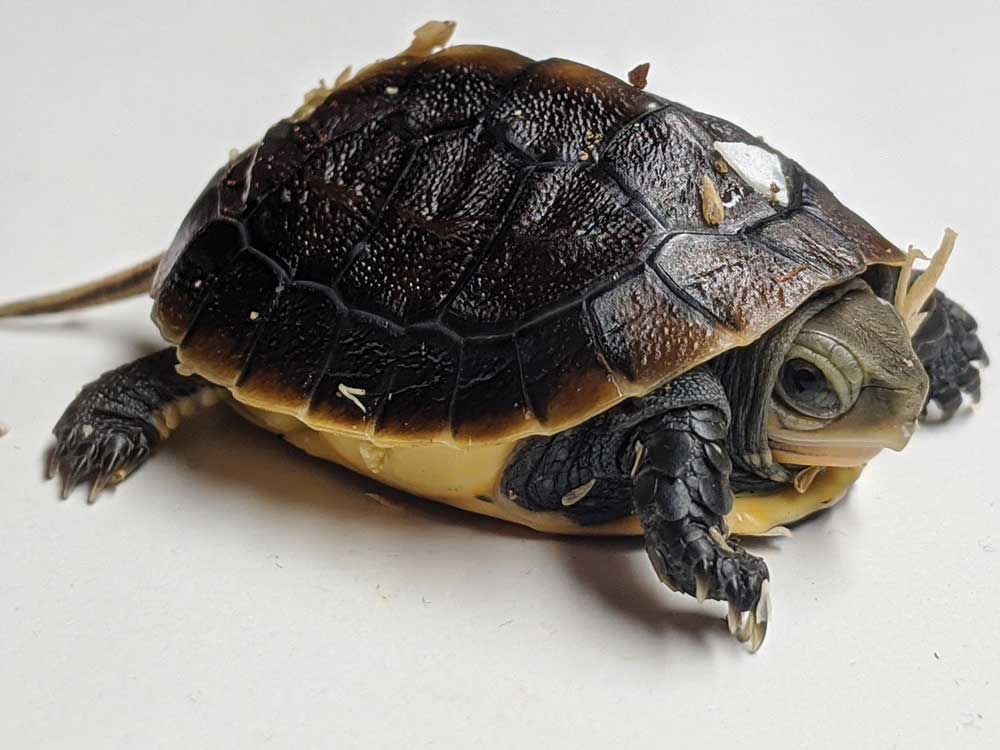
Flavos occur in southern China as well as Taiwan and the Ryukyu Islands. Photo by Anthony Pierlioni.
Chinese Box Turtle Hatchling Care
There’s a bit of a recurring theme here. The hatchlings are easy, as well. Egg size, and subsequently hatchling size, can vary greatly. However, the hatchlings are generally larger in size. If they were a North American species, they may lay 15 egg clutches, but generally we see one to three eggs per clutch.
As mentioned earlier, pellets are recommended as the staple diet, even for hatchlings. Pellets are always accepted as a first meal after hatching. Hatchlings will even take full-sized adult pellets, so there is no need to feed these omnivores any tiny pellets meant only for hatchlings.
Small juveniles and hatchlings are kept in small Tupperware or plastic shoebox containers. These tubs must be transparent to allow ambient light to enter the tub and provide a day/night cycle.
Water is kept shallow, perhaps one half to one full inch in depth (depending on the size of the turtle), with a generous amount of sphagnum moss for the turtle(s) to feel secure. It is appropriate to have the water level at ¼ of the straight carapace length, or SCL. A one-inch turtle should be in ¼-inch of water, while a four-inch juvenile would thrive in one full inch of water. The turtles can be fed directly in the container, so they can continue to hide and eat at the same time, the way they would prefer to even in the wild.
Box turtle research is often completely devoid of hatchling data, because these turtles live completely different lives than the adults. They hide under leaves, in wet areas, where they can find small invertebrates. Bright light of the direct sun would likely stress them, so cover is surely more important than UVB at this stage. The water and sphagnum moss within it are very easily cleaned by using a pasta strainer to rinse the moss. Filtration is extremely difficult to provide with such shallow water, especially when filled with moss.
What is a Good Beginner Turtle?
It can be tough to quantify exactly what makes a species the right one for your family or your breeding programs. Generally, things like overall hardiness take precedence in these designations. Perhaps that is part of the reason species like the red-eared slider (Trachemys scripta elegans), continue to be listed as beginner species, despite their aggressive nature and aquatic habitat requirements.
The assessment that flavos are a beginner species would also be irresponsible. They are not super small, their endangered status makes them a species that should probably be bred, whenever possible, and they do have some specific requirements like saturation and varied diet that are not easy for all keepers to provide.
With that said, flavos are everything a dedicated reptile champion could ever want. They are hardy, personable, and prolific. As long as you provide the very few imperative items, they are as good as it gets.
Anthony Pierlioni is the vice president of theTurtleRoom, an international turtle conservation organization. He also works in veterinary leadership and regional training. Anthony keeps and breeds numerous endangered turtle and tortoise species and works to educate the public about their plight. His book on the Geoemyda genus was published by Living Art Publishing in 2016. Anthony is also the host of the “Pondcast,” the world’s first turtle podcast, and “Turtley Devoted,” a show about turtles, the people who love them, and the people who love them. Follow him on Instagram and FaceBook.

